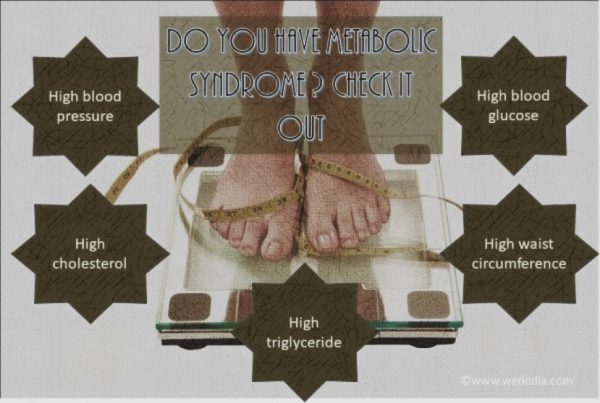
Do you have metabolic syndrome?
Have you heard about Metabolic syndrome?
In recent years this one medical term has answered many questions about common conditions that people are suffering from.
Metabolic syndrome is the name given to group of risk factors or conditions that arises when we increase our risk heart conditions and type 2 diabetes.
This includes hypertension, large waist, high triglyceride levels, low HDL cholesterol level and above normal blood sugar levels.
Metabolic is the term used for biochemical processes involved in body’s normal functioning. Syndrome refers to the symptoms and conditions that causes disruptions to metabolism.
Presence of three or more of these below risk factors determine whether a person has metabolic syndrome or not.
- Central obesity. This is measured by waist circumference:
- More than 40 inches for men.
- More than 35 inches for women.
- Fasting blood triglycerides are 150 mg/dL or more or taking medicine for high triglycerides.
- Low HDL cholesterol levels or taking medicine for low HDL cholesterol:
- Men — Less than 40 mg/dL
- Women — Less than 50 mg/dL
- Elevated blood pressure of 130/85 mm Hg or higher or taking medicine for high blood pressure.
- Fasting glucose (blood sugar) of 100 mg/dL or more or taking medicine for high blood glucose.
Other body conditions like a fatty liver, polycystic ovarian syndrome, gallstones, breathing problems during sleep play a role in metabolic syndrome. Genetic factors like ethnicity and family history may play a role too. Risk of metabolic syndrome increases with age.
How is metabolic syndrome treated?
Best way to prevent metabolic syndrome is to adopt healthy lifestyle. Changing the lifestyle for better health really helps. Routine checkups on above mentioned risk factors and improving the levels of the factors helps. Losing weight, healthy diet and increased physical activity are three mantras one should practice.
To manage metabolic syndrome, follow these important steps.
- Routinely monitor body weight (especially central obesity).
- Monitor blood glucose, lipoproteins and blood pressure.
- Treat individual risk factors (hyperlipidemia, high blood pressure and high blood glucose) according to established guidelines.
- Carefully choose high blood pressure drugs because different drugs have different effects on insulin sensitivity.
Lifestyle changes can help to control risk factors:
- Eat healthy
- Aim for healthy weight
- Manage stress
- Physical activity
- Quit smoking
Prepare yourself for a realistic short and long term goals and work closely with your doctor to manage your health.
References:
- http://health.facty.com
- https://www.nhlbi.nih.gov
- http://www.heart.org/
Author: Sumana Rao | Posted on: May 17, 2019






















Write a comment